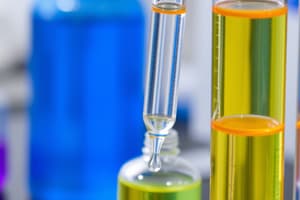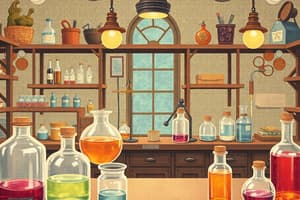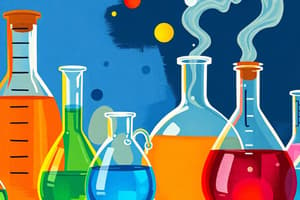Podcast
Questions and Answers
Aristotle identified the four elements: Earth, Water, Fire, and ______.
Aristotle identified the four elements: Earth, Water, Fire, and ______.
Air
Alchemy was believed to allow for the transformation of cheap metals into ______.
Alchemy was believed to allow for the transformation of cheap metals into ______.
gold
The process of creating acids was developed by ______.
The process of creating acids was developed by ______.
alchemists
Anaxagoras proposed that every substance had its own kind of ______.
Anaxagoras proposed that every substance had its own kind of ______.
Signup and view all the answers
In ordinary chemistry, we cannot transmute elements with a chemical ______.
In ordinary chemistry, we cannot transmute elements with a chemical ______.
Signup and view all the answers
The concept of distillation is a technique discovered during the practice of ______.
The concept of distillation is a technique discovered during the practice of ______.
Signup and view all the answers
Transmutation, as described in alchemical practices, only involved the physical ______ of a substance.
Transmutation, as described in alchemical practices, only involved the physical ______ of a substance.
Signup and view all the answers
The alchemist's lab apparatus included several types of allow and ______.
The alchemist's lab apparatus included several types of allow and ______.
Signup and view all the answers
A ______ is used to heat substances to high temperatures and conduct reactions.
A ______ is used to heat substances to high temperatures and conduct reactions.
Signup and view all the answers
A ______ separates substances based on density by spinning them at high speeds.
A ______ separates substances based on density by spinning them at high speeds.
Signup and view all the answers
Measuring precise volumes can be done using tools like ______ and burettes.
Measuring precise volumes can be done using tools like ______ and burettes.
Signup and view all the answers
A ______ is used to test the acidity or alkalinity of a solution.
A ______ is used to test the acidity or alkalinity of a solution.
Signup and view all the answers
The process of ______ involves applying heat to accelerate reactions or evaporate solvents.
The process of ______ involves applying heat to accelerate reactions or evaporate solvents.
Signup and view all the answers
During experiments, ______ is important for monitoring physical and chemical changes.
During experiments, ______ is important for monitoring physical and chemical changes.
Signup and view all the answers
A ______ is used to support a crucible over a heat source for heating.
A ______ is used to support a crucible over a heat source for heating.
Signup and view all the answers
The process of ______ involves forming solid crystals from a solution as it cools or evaporates.
The process of ______ involves forming solid crystals from a solution as it cools or evaporates.
Signup and view all the answers
A ______ is designed for reactions that may release gases or splatter.
A ______ is designed for reactions that may release gases or splatter.
Signup and view all the answers
A ______ is used to grind and mix solid substances into finer powders.
A ______ is used to grind and mix solid substances into finer powders.
Signup and view all the answers
To measure volumes of liquids, scientists use a graduated ______.
To measure volumes of liquids, scientists use a graduated ______.
Signup and view all the answers
A ______ holds and organizes multiple test tubes upright.
A ______ holds and organizes multiple test tubes upright.
Signup and view all the answers
A ______ is used to accurately measure and transfer small volumes of liquids.
A ______ is used to accurately measure and transfer small volumes of liquids.
Signup and view all the answers
A Bunsen burner provides a controlled flame for heating ______.
A Bunsen burner provides a controlled flame for heating ______.
Signup and view all the answers
The ______ is used to cover beakers or evaporating dishes and hold small amounts of solids.
The ______ is used to cover beakers or evaporating dishes and hold small amounts of solids.
Signup and view all the answers
The ______ supports equipment like beakers and flasks over a flame or heat source.
The ______ supports equipment like beakers and flasks over a flame or heat source.
Signup and view all the answers
Study Notes
Laboratory Equipment
- Heatproof Mat: Protects surfaces from heat damage and spills during experiments.
- Clay Triangle: Supports a crucible over a heat source for heating purposes.
- Evaporating Dish: Used for heating liquids to evaporate solvents, leaving solid residues.
- Crucible: Designed for heating substances to high temperatures and conducting reactions.
- Crucible Tongs: Allow safe handling of hot crucibles and other hot materials.
- Clamp Stand (Ring Stand): Holds laboratory equipment in place during experiments for stability.
- Litmus Paper: Tests acidity or alkalinity of a solution.
- Universal Indicator: Shows pH levels of a solution through color changes.
- Thermometer: Measures the temperature of substances, typically using mercury.
- Centrifuge: Separates substances based on density by spinning at high speeds.
Common Laboratory Operations
- Measuring: Utilizes pipettes and burettes to determine precise volumes.
- Mixing: Involves combining substances to create a solution or reaction.
- Heating: Applies heat to accelerate reactions or evaporate solvents.
- Titration: Adds a reagent to determine the concentration of a solution.
- Filtration: Separates solid particles from liquids using a filter.
- Distillation: Purifies liquids by heating and condensing vapors.
- Crystallization: Forms solid crystals from a solution as it cools or evaporates.
- Extraction: Isolates substances from mixtures using solvents.
- Weighing: Measures mass of substances with a balance.
- Observing: Monitors physical and chemical changes during experiments.
Additional Laboratory Equipment
- Beaker: Holds, mixes, and heats liquids; ideal for general tasks.
- Erlenmeyer Flask: Designed for reactions that emit gases or splatter, ensuring better containment.
- Measuring Cylinder: Graduated tool for measuring liquid volumes.
- Mortar and Pestle: Grind and mix solids into finer powders.
- Test Tubes: Hold, mix, and heat small quantities; can culture microorganisms.
- Test Tube Holder: Secures and handles test tubes during heating or mixing.
- Test Tube Racks: Organizes multiple test tubes upright.
- Rubber Bungs: Secure test tubes or flasks in place during experiments.
- Watch Glass: Covers beakers or dishes, holds small solids.
- Stirring Rod: Mixes liquids and transfers drops of solutions.
- Funnel: Transfers liquids or powders between containers.
- Pipette: Accurately measures and transfers small liquid volumes.
- Spatulas: Scoops and transfers small solid chemical amounts.
- Forceps: Picks up small objects safely.
- Scalpel: Provides precise cutting or dissection capabilities.
- Burette: Accurately dispenses and measures variable liquid volumes.
- Bunsen Burner: Produces a controlled flame for heating.
- Tripod: Supports equipment like beakers over a heat source.
- Gauze: Provides a stable heating surface and evenly distributes heat.
Historical Concepts in Chemistry
- Aristotle's Four Elements: Earth (cool, heavy), Water (wet), Air (light), Fire (hot); ideas of qualities like heat, cold, moisture, and dryness.
- Alchemy: Early chemistry believed in transmutation, converting cheap metals into gold; involved practices like distillation and recrystallization.
- Anaxagoras: Introduced the concept of "seeds" in substances, akin to modern atomic theory.
- Transmutation: Alchemical belief that physical appearance changes without chemical alteration; not supported by modern chemistry.
- Legacy of Alchemy: Developed experimental techniques, apparatus, and glassware. Pseudoscience label indicates a departure from true scientific methods.
Studying That Suits You
Use AI to generate personalized quizzes and flashcards to suit your learning preferences.
Related Documents
Description
Test your knowledge on essential laboratory equipment and common operations used in experiments. From heatproof mats to centrifuges, this quiz covers tools and techniques critical for conducting scientific experiments safely and effectively.




